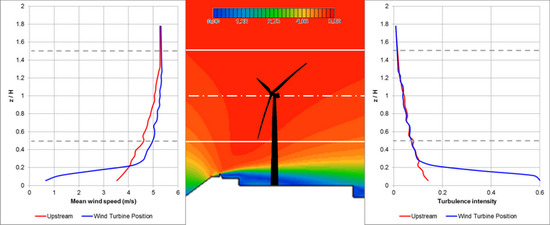Experimental and Numerical Analysis of a Seawall’s Effect on Wind Turbine Performance
Abstract
1. Introduction
2. Data and Methods
2.1. Analysis Procedure
- First, a wind tunnel experiment was conducted using a downscaled model (1/100) of the Gunsan wind farm on the west coast of South Korea. Through this, how the atmospheric boundary layer of downwind was deformed by the seawall structure located in the upwind of the wind turbine was experimentally investigated.
- Next, a semi-2D CFD analysis of the same dimensions and flow conditions as those of the model used in the wind tunnel experiment was conducted. In this analysis, a number of turbulence models were tested, and the model that proved to be most effective in analyzing the flow separation-accompanied turbulent wind flow was selected.
- First, a CFD analysis was conducted using the full-scale seawall to overcome the limitation of the Reynolds number similarity in the wind tunnel experiment, and to verify whether the seawall had the same positive and negative effects as those seen in the analysis of the full-scale seawall.
- Finally, the Supervisory Control and Data Acquisition (SCADA) data of the Gunsan wind farm were analyzed to verify the wind shear mitigation effects, which were confirmed by the wind tunnel experiment and CFD simulation. That is, the hypothesis that the seawall would increase power generation if there was a difference in power generation made during westerly wind, which is the sea breeze, and easterly wind, the opposite wind direction, was quantitatively and practically verified.
2.2. Wind Tunnel Experiment
2.2.1. Wind Conditions at the Gunsan Wind Farm
2.2.2. Simulated Wind Condition in the Wind Tunnel
2.2.3. Downscaled Seawall Model
2.3. Wind Tunnel Experiment
2.4. Wind Farm SCADA Data
3. Results and Discussion
3.1. Downscaled Model Validation
3.2. Full-Scale Model Validation
3.3. Wind Power Augmentation
4. Conclusions
- (1)
- The comparative validation results of the wind tunnel experiment and the CFD using the downscaled model indicate that the MP k-ε model was the most suitable turbulence model to analyze the wind field, which was accompanied by flow separation.
- (2)
- Wind speed-up and wind shear mitigation occurred not only in the wind turbine hub height but also in the entire rotor plane due to the virtual hill effect, which was produced by the seawall slope and the recirculation zone on the rear side of the seawall. Both of them played a role in increasing power generation, and the SCADA data analysis of the Gunsan wind farm confirmed an effect equivalent to an increase in power generation of about 1.5% by a mitigation of the wind profile, which is comparable to the theoretical increase of 1.4% estimated by the wind profiles of CFD simulations.
- (3)
- The flow separation occurring at the upper top of the seawall rapidly increased the turbulence intensity, but its impact range was lower than 1/4 of the wind turbine hub height, which confirmed that there was no adverse effect on the rotor blades, such as when applying fatigue loads directly.
- (4)
- If wind farms are developed near civil engineering structures such as seawalls or escarpments in the future, increases in power generation could be achieved by selecting a location where wind speed-up and wind shear mitigation are expected based on the results of this study.
Author Contributions
Funding
Conflicts of Interest
References
- Kim, H.G.; Kang, Y.H.; Kim, J.Y. Evaluation of wind resource potential in mountainous region considering morphometric terrain characteristics. Wind Eng. 2017, 41, 114–123. [Google Scholar] [CrossRef]
- Kim, J.S.; Kim, H.G.; Park, H.D. Surface wind regionalization based on similarity of time-series wind vectors. Asian J. Atmos. Environ. 2016, 10, 80–89. [Google Scholar] [CrossRef]
- Kim, H.G.; Jang, M.S. A Structure for Compensating Wind Velocity. Korea Patent 10-0969595, 5 July 2010. [Google Scholar]
- Wood, N. The onset of flow separation in neutral, turbulent flow over hills. Bound. Layer Meteorol. 1995, 76, 137–164. [Google Scholar] [CrossRef]
- Wagner, R.; Cañadillas, B.; Clifton, A.; Feeney, S.; Nygaard, N.; Poodt, M.; St Martin, C.; Tüxen, E.; Wagenaar, J. Rotor equivalent wind speed for power curve measurement—Comparative exercise for IEA Wind Annex 32. J. Phys. Conf. Ser. 2014, 524, 012108. [Google Scholar] [CrossRef]
- Bitsuamlak, G.T.; Stathopoulos, T.; Bédard, C. Numerical evaluation of wind flow over complex terrain: Review. J. Aerosp. Eng. 2004, 17, 135–145. [Google Scholar] [CrossRef]
- Barthelmie, R.J.; Wang, H.; Doubrawa, P.; Giroux, G.; Pryor, S.C. Effects of an escarpment on flow parameters of relevance to wind turbines. Wind Energy 2016, 19, 2271–2286. [Google Scholar] [CrossRef]
- Tobin, N.; Chamorro, L.P. Windbreak effects within infinite wind farms. Energies 2017, 10, 1140. [Google Scholar] [CrossRef]
- Kim, H.G. A method of accelerating the convergence of computational fluid dynamics for micro-siting wind mapping. Computation 2019, 7, 22. [Google Scholar] [CrossRef]
- Ramos, D.A.; Guedes, V.G.; Pereira, R.R.S.; Valentim, T.A.S.; Netto, W.A.C. Further considerations on WAsP, OpenWind and WindSim comparison study: Atmospheric flow modelling over complex terrain and energy production estimate. In Proceedings of the Windpower 2017 Conference and Exhibition, Rio De Janeiro, Brazil, 29–31 August 2017. [Google Scholar]
- Ishihara, T.; Qi, Y. Numerical study of turbulent flow fields over steep terrain by using modified delayed detached-eddy simulations. Bound. Layer Meteorol. 2019, 170, 45–68. [Google Scholar] [CrossRef]
- Liu, Z.; Cao, S.; Liu, H.; Ishihara, T. Large-eddy simulations of the flow over an isolated three-dimensional hill. Bound. Layer Meteorol. 2019, 170, 415–441. [Google Scholar] [CrossRef]
- Bechmann, A.; Sørensen, N.N.; Berg, J.; Mann, J.; Réthoré, P.E. The Bolund experiment, Part II: Blind comparison of microscale flow models. Bound. Layer Meteorol. 2011, 141, 245–271. [Google Scholar] [CrossRef]
- Uchida, T. Computational fluid dynamics approach to predict the actual wind speed over complex terrain. Energies 2018, 11, 1694. [Google Scholar] [CrossRef]
- Uchida, T. High-resolution LES of terrain-induced turbulence around wind turbine generators by using turbulent inflow boundary conditions. Open J. Fluid Dyn. 2017, 7, 511–524. [Google Scholar] [CrossRef]
- Conan, B.; Chaudhari, A.; Aubrun, S.; van Beeck, J.; Hämäläinen, J.; Hellsten, A. Experimental and numerical modelling of flow over complex terrain: The Bolund hill. Bound. Layer Meteorol. 2016, 158, 183–208. [Google Scholar] [CrossRef]
- Chaudhari, A.; Vuorinen, V.; Hämäläinen, J.; Hellsten, A. Large-eddy simulations for hill terrains: Validation with wind-tunnel and field measurements. Comp. Appl. Math. 2018, 37, 2017–2038. [Google Scholar] [CrossRef]
- Kimura, K. Chapter 3—Wind loads. In Innovative Bridge Design Handbook—Construction, Rehabilitation and Maintenance; Pipinato, A., Ed.; Elsevier: Amsterdam, The Netherlands, 2016; pp. 37–48. [Google Scholar]
- Cook, M.V. Chapter 12—Aerodynamic modelling. In Flight Dynamics Principles, 3rd ed.; Elsevier: Oxford, UK, 2013; pp. 353–369. [Google Scholar]
- Korea Institute of Energy Research. Korea Renewable Energy Resource Atlas, 3rd ed.; New & Renewable Energy Resource Center, Ministry of Science, ICT and Future Planning: Daejeon, Korea, 2018.
- Ha, Y.-C.; Lee, B.-H.; Kim, H.-G. Effect of wind speed up by seawall on a wind turbine. J. Korean Sol. Energy Soc. 2013, 33, 1–8. [Google Scholar] [CrossRef][Green Version]
- Korea Ministry of Land, Infrastructure and Transport. Korea Building Code-Structural, The Act of Ministry of Land, Infrastructure and Transport; The National Law Information Center: Seoul, Korea, 2016.
- Von Karman, T. Progress in Statistical Theory of Turbulence. Proc. Natl. Acad. Sci. USA 1948, 34, 530–539. [Google Scholar] [CrossRef]
- Simiu, E. Toward a Standard on the Wind Tunnel Method; NIST Technical Note 1655; U.S. Dept. of Commerce: Gaithersburg, MD, USA, 2009.
- Kim, H.G.; Patel, V.C. Test of turbulence models for wind flow over terrain with separation and recirculation. Bound. Layer Meteorol. 2000, 94, 5–21. [Google Scholar] [CrossRef]
- Kim, H.G.; Lee, C.M.; Lim, H.C. An experimental and numerical study on the flow over two-dimensional hills. J. Wind Eng. Ind. Aerodyn. 1997, 66, 17–33. [Google Scholar] [CrossRef]
- Wagner, R.; Courtney, M.; Gottschall, J.; Lindelöw-Marsden, P. Accounting for the speed shear in wind turbine power performance measurement. Wind Energy 2011, 14, 993–1004. [Google Scholar] [CrossRef]
- Van Sark, W.G.J.H.M.; Van der Velde, H.C.; Coelingh, J.P.; Bierbooms, W.A.A.M. Do we really need rotor equivalent wind speed? Wind Energy 2019, 22, 745–763. [Google Scholar] [CrossRef]
- Kato, M.; Launder, B.E. The Modeling of turbulent flow around stationary and vibrating square cylinders. In Proceeding of the 9th Symposium on Turbulent Shear Flows, Kyoto, Japan, 16–18 August 1993. [Google Scholar]
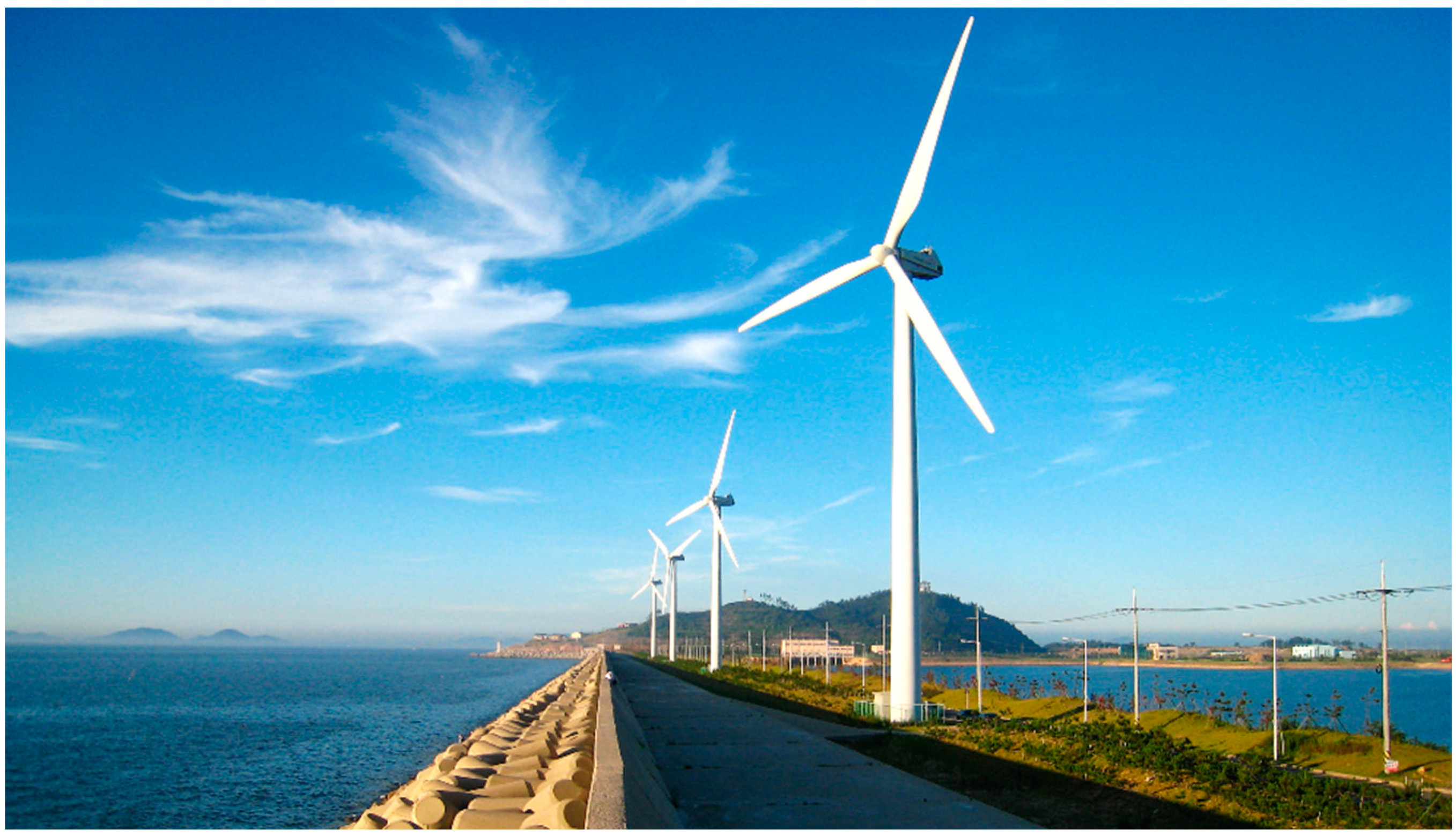
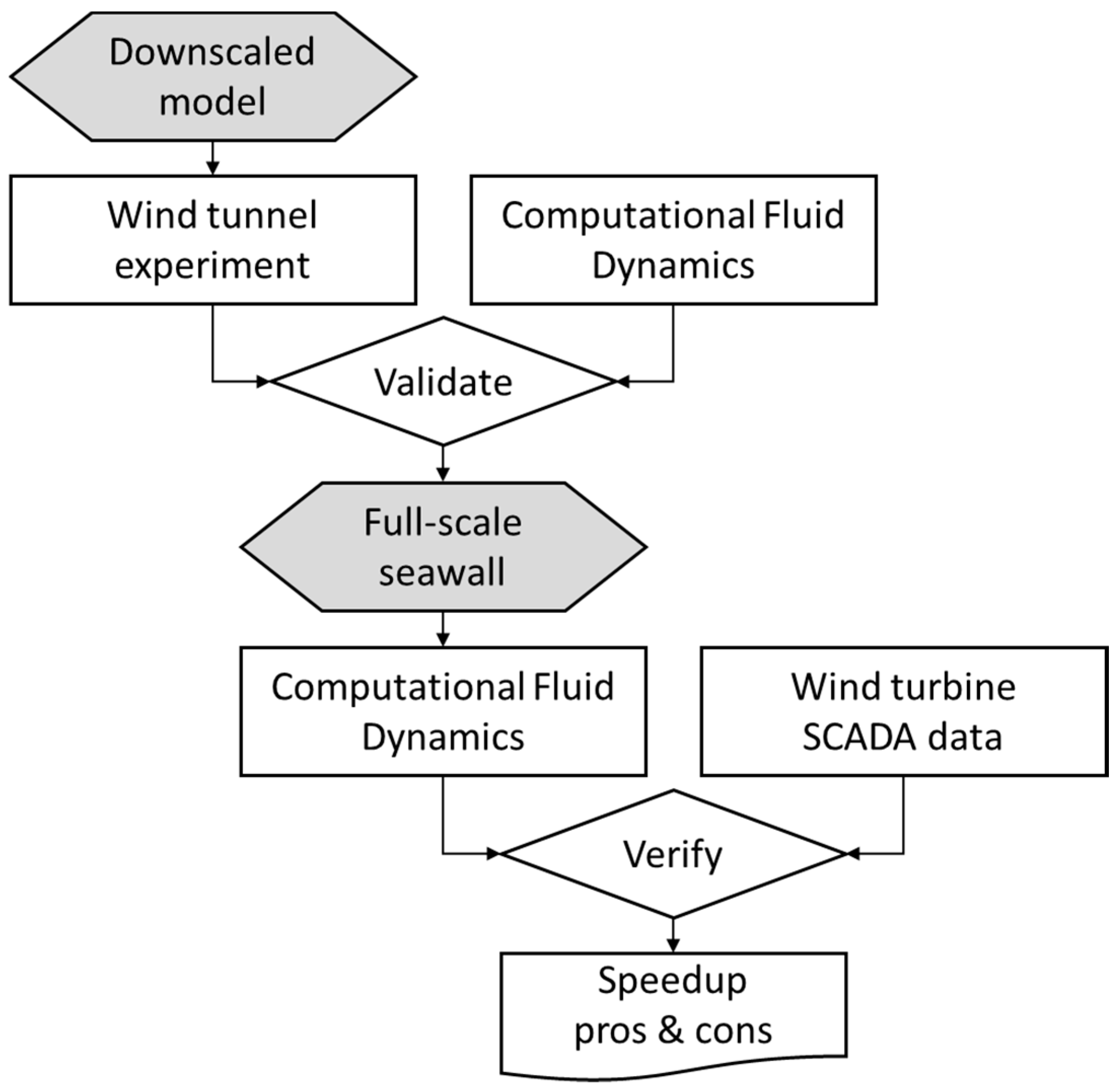
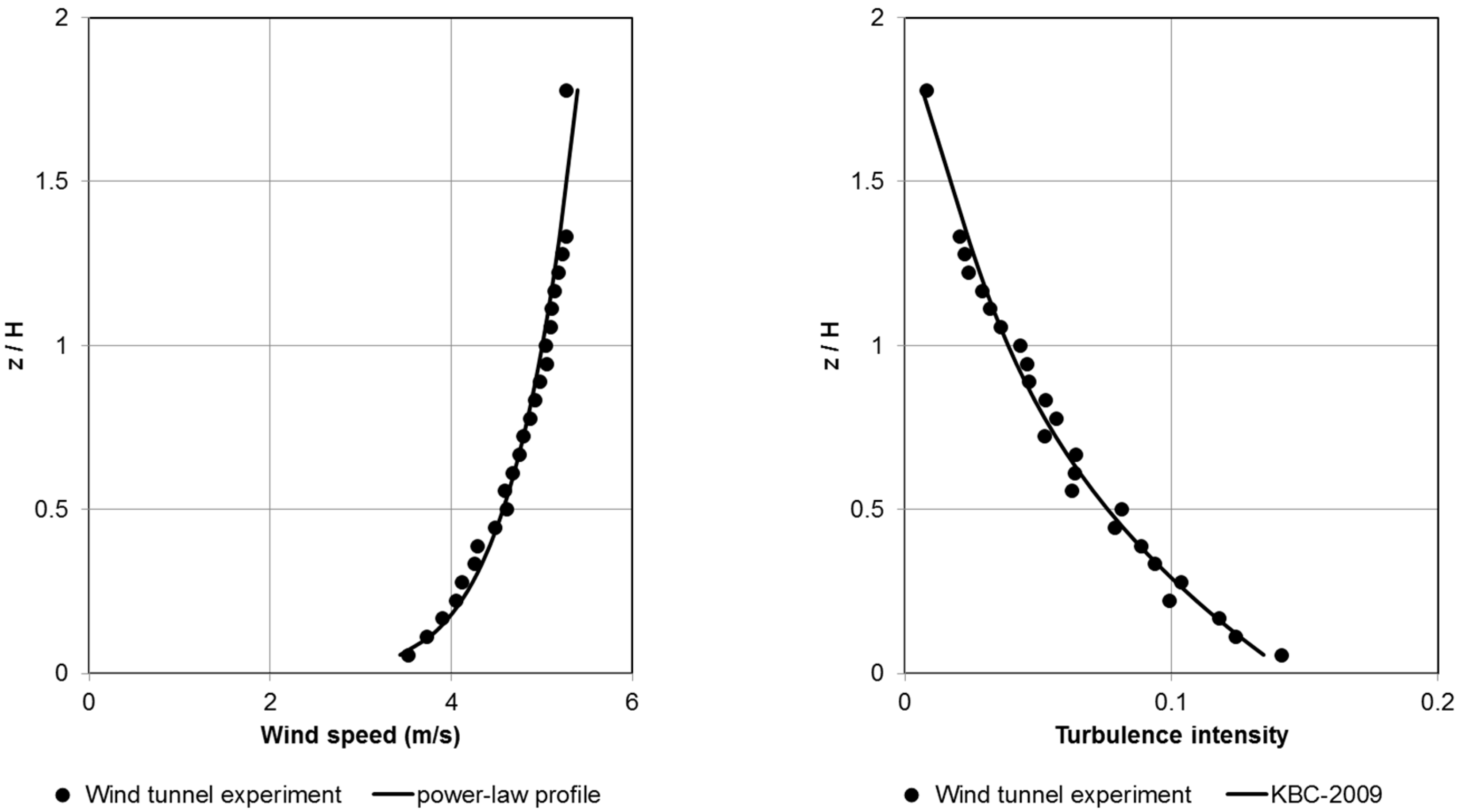
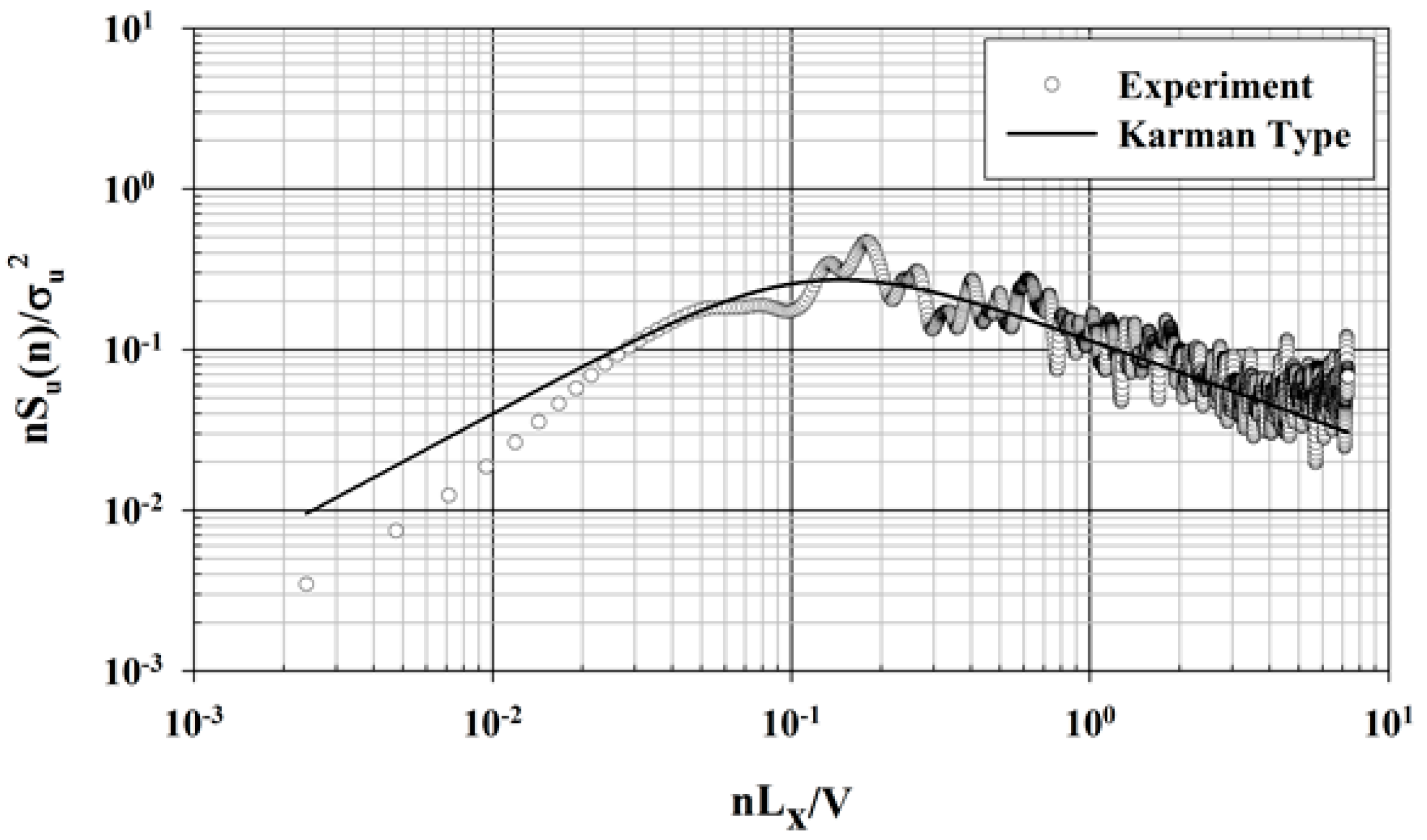
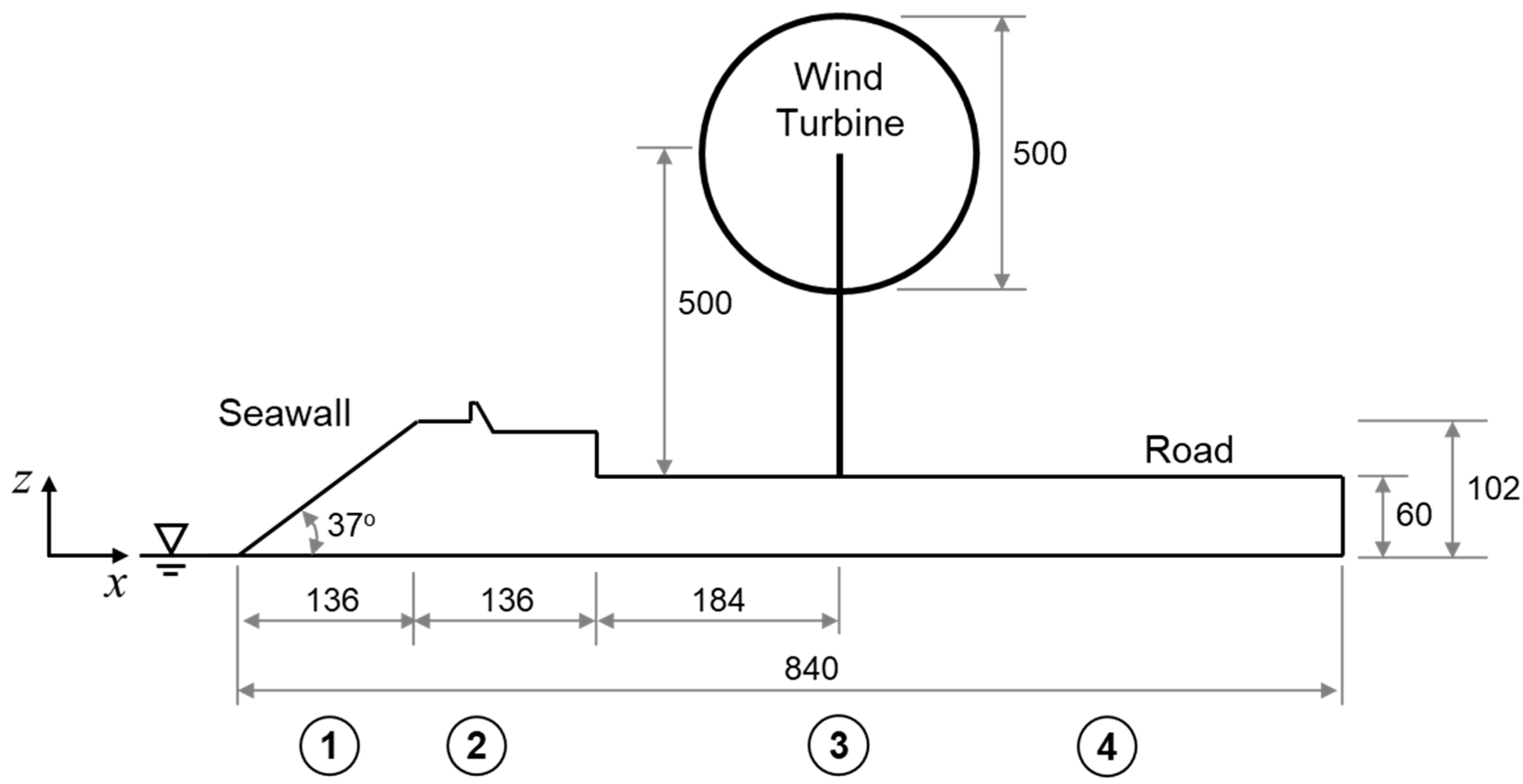
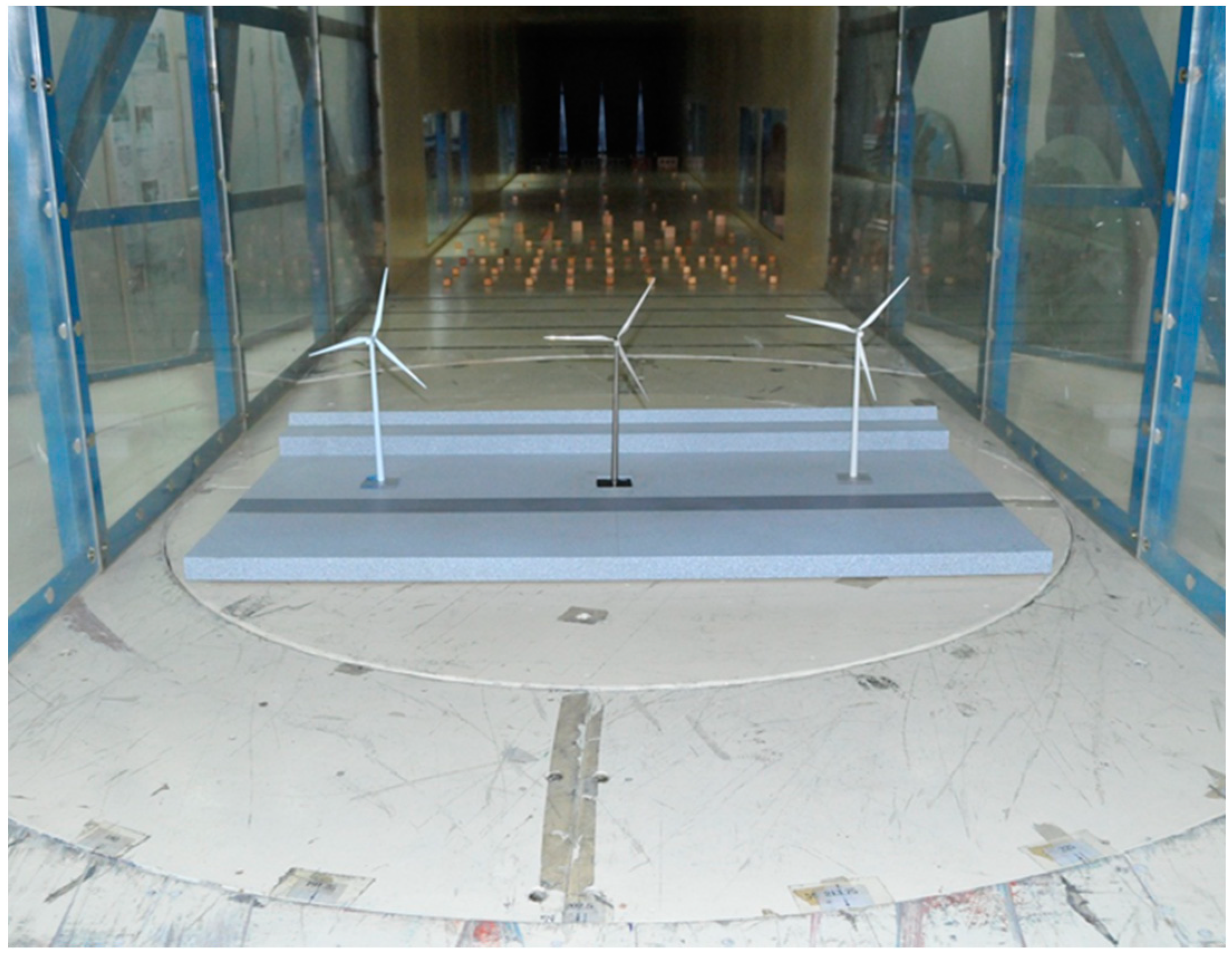
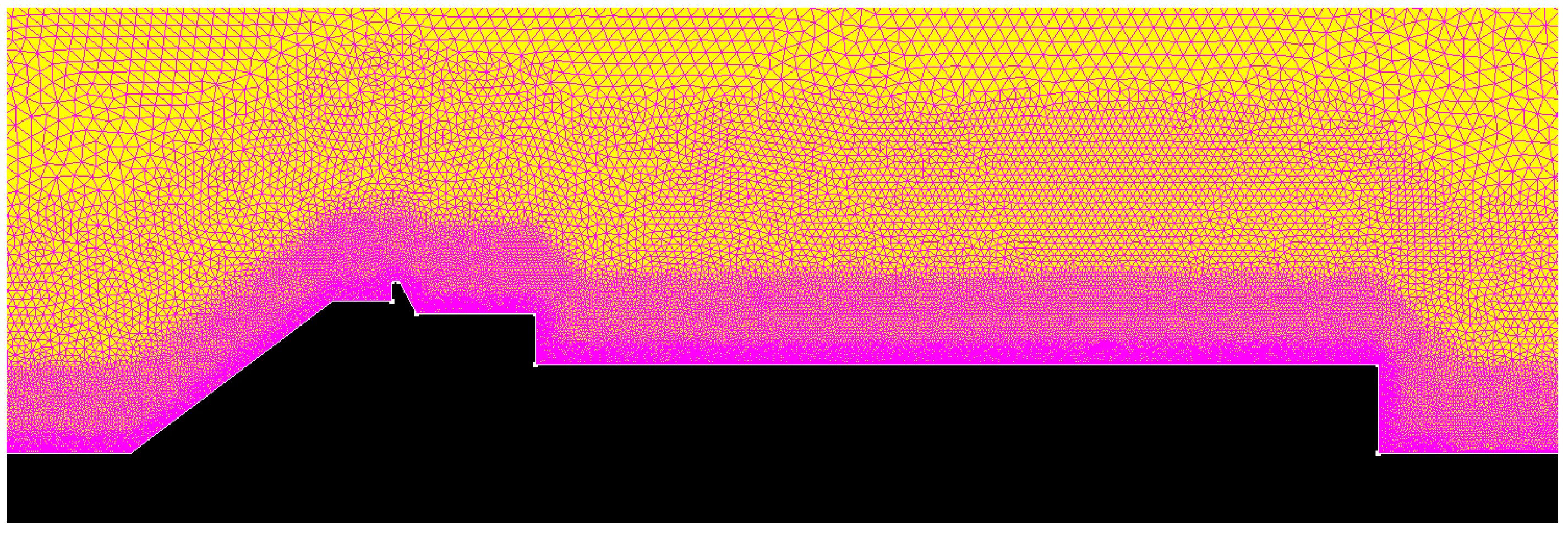


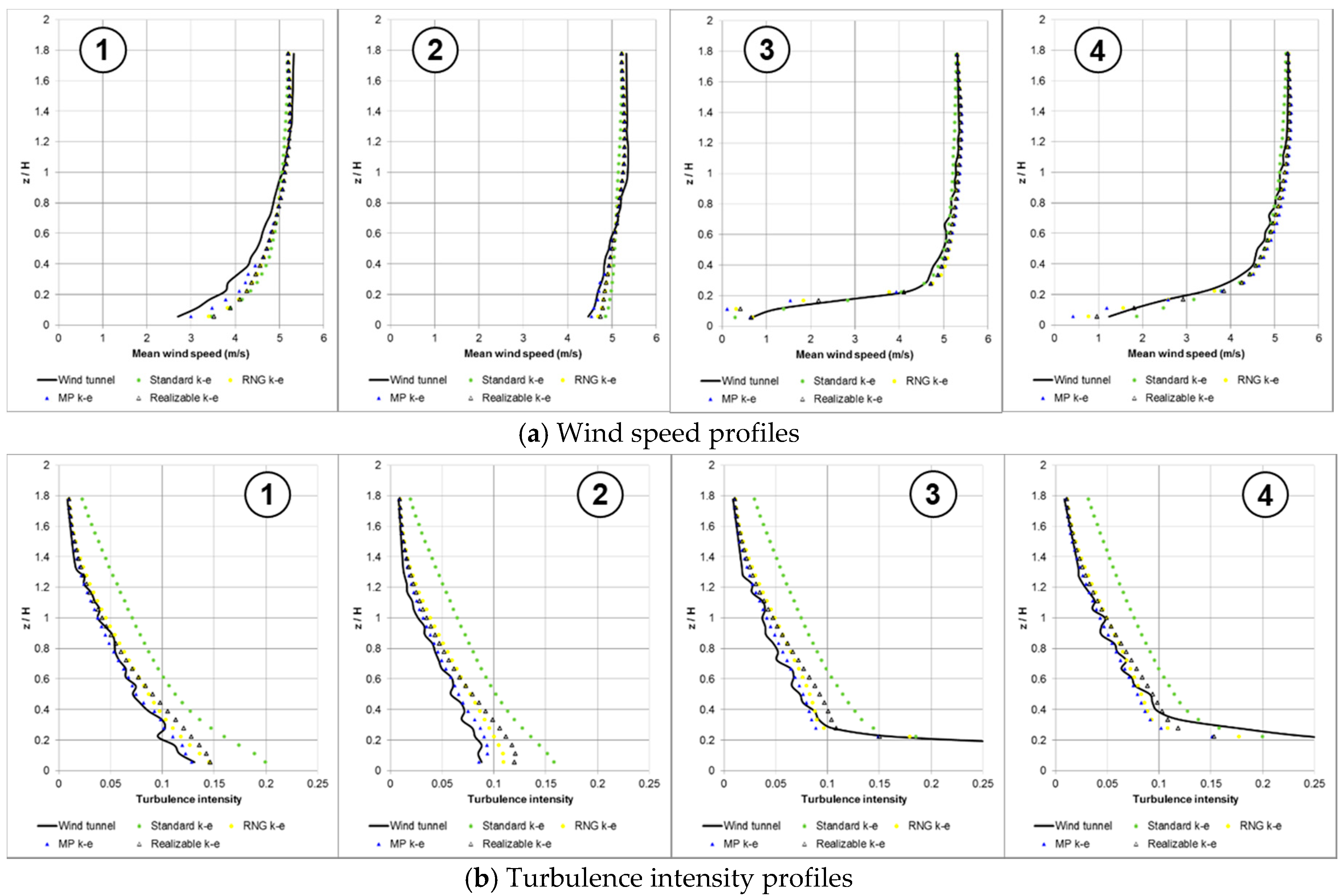



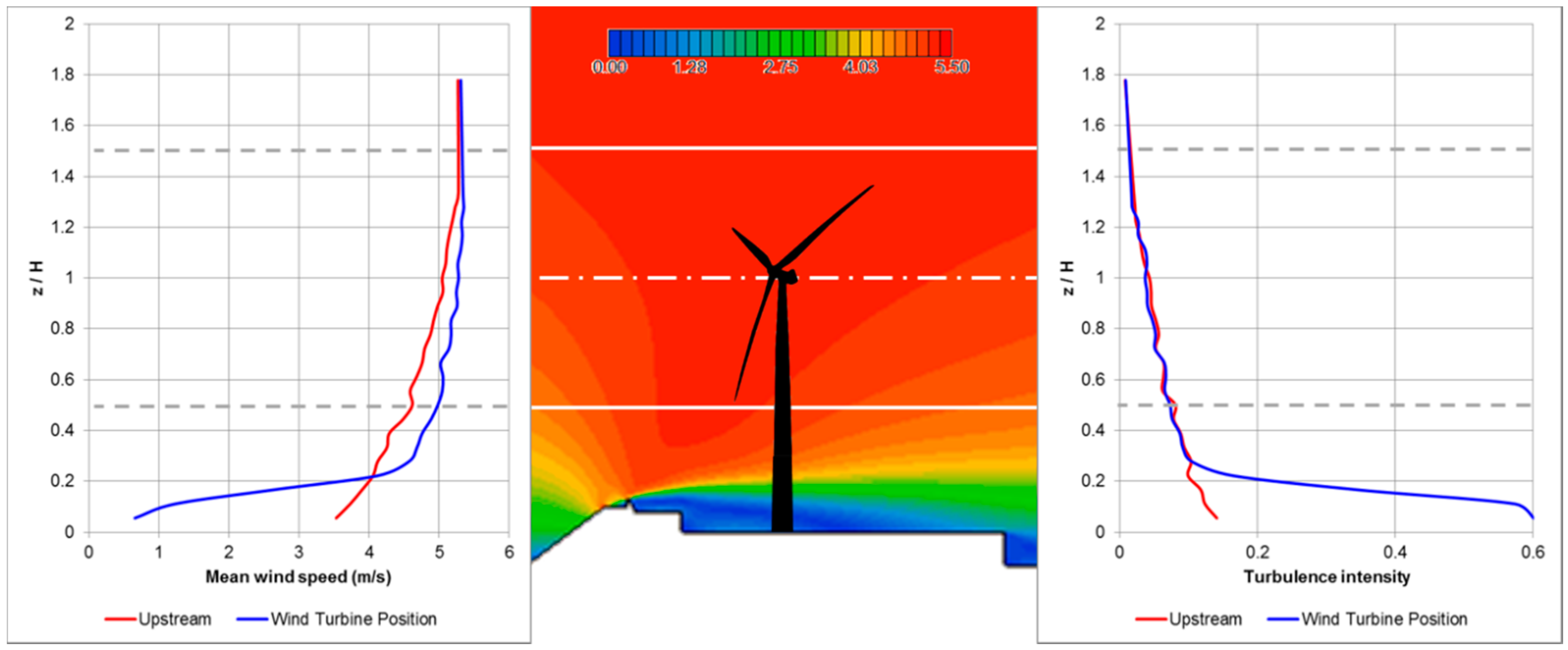

| Case | 0° | 11.25° | 22.5° |
|---|---|---|---|
| Ebb tide | 10.0 | 8.6 | 7.6 |
| High tide | 7.6 | 7.4 | 6.2 |
© 2019 by the authors. Licensee MDPI, Basel, Switzerland. This article is an open access article distributed under the terms and conditions of the Creative Commons Attribution (CC BY) license (http://creativecommons.org/licenses/by/4.0/).
Share and Cite
Kim, H.-G.; Jeon, W.-H. Experimental and Numerical Analysis of a Seawall’s Effect on Wind Turbine Performance. Energies 2019, 12, 3877. https://doi.org/10.3390/en12203877
Kim H-G, Jeon W-H. Experimental and Numerical Analysis of a Seawall’s Effect on Wind Turbine Performance. Energies. 2019; 12(20):3877. https://doi.org/10.3390/en12203877
Chicago/Turabian StyleKim, Hyun-Goo, and Wan-Ho Jeon. 2019. "Experimental and Numerical Analysis of a Seawall’s Effect on Wind Turbine Performance" Energies 12, no. 20: 3877. https://doi.org/10.3390/en12203877
APA StyleKim, H.-G., & Jeon, W.-H. (2019). Experimental and Numerical Analysis of a Seawall’s Effect on Wind Turbine Performance. Energies, 12(20), 3877. https://doi.org/10.3390/en12203877





